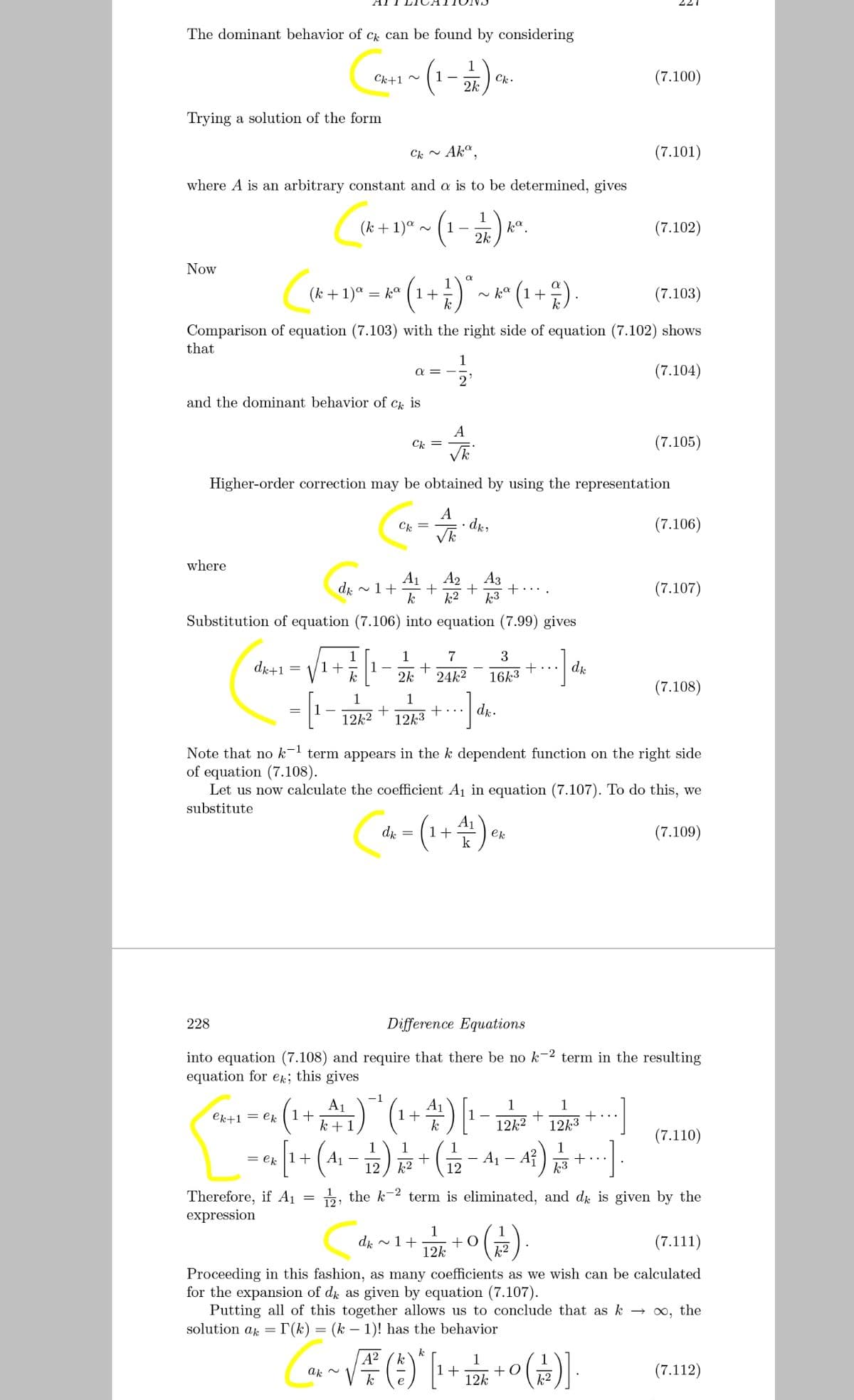Trying a solution of the form Ck ~ Aka, (7.101) where A is an arbitrary constant and a is to be determined, gives 1 ka. 2k (k + 1)" - 1- (7.102) Now (*+r - (1+)" ~ k° (1+). = ka (7.103) Comparison of equation (7.103) with the right side of equation (7.102) shows that 1 a = (7.104) 2' and the dominant behavior of Ck is A Ck = (7.105) Higher-order correction may be obtained by using the representation A Ck = · dg, (7.106) where A2 A1 di -1+ k A3 k3 (7.107) Substitution of equation (7.106) into equation (7.99) gives 1 7 3 dr+1 1+ 1- k 2k 24k2 16k3 (7.108) 1 1 +.. dz. 12k2 12k3 Note that nok- term appears in the k dependent function on the right side of equation (7.108). Let us now calculate the coefficient A1 in equation (7.107). To do this, we substitute di = 1+ ek k (7.109)
Trying a solution of the form Ck ~ Aka, (7.101) where A is an arbitrary constant and a is to be determined, gives 1 ka. 2k (k + 1)" - 1- (7.102) Now (*+r - (1+)" ~ k° (1+). = ka (7.103) Comparison of equation (7.103) with the right side of equation (7.102) shows that 1 a = (7.104) 2' and the dominant behavior of Ck is A Ck = (7.105) Higher-order correction may be obtained by using the representation A Ck = · dg, (7.106) where A2 A1 di -1+ k A3 k3 (7.107) Substitution of equation (7.106) into equation (7.99) gives 1 7 3 dr+1 1+ 1- k 2k 24k2 16k3 (7.108) 1 1 +.. dz. 12k2 12k3 Note that nok- term appears in the k dependent function on the right side of equation (7.108). Let us now calculate the coefficient A1 in equation (7.107). To do this, we substitute di = 1+ ek k (7.109)
Algebra & Trigonometry with Analytic Geometry
13th Edition
ISBN:9781133382119
Author:Swokowski
Publisher:Swokowski
Chapter1: Fundamental Concepts Of Algebra
Section1.3: Algebraic Expressions
Problem 32E
Related questions
Topic Video
Question
Explain the determine yellow

Transcribed Image Text:The dominant behavior of Ck can be found by considering
(7.100)
1 -
Ck+1 ~
Ck.
2k
Trying a solution of the form
Ck ~ Akª.
(7.101)
where A is an arbitrary constant and a is to be determined, gives
1
ka.
2k
(k + 1)ª ~
1 -
(7.102)
Now
1
1+-
(1+).
(k + 1)ª = ka
~ ka
(7.103)
Comparison of equation (7.103) with the right side of equation (7.102) shows
that
1
(7.104)
2
and the dominant behavior of C is
A
Ck =
(7.105)
Higher-order correction may be obtained by using the representation
A
VE
(7.106)
Ck
where
A1
di ~1+
k
A3
+·….
k3
A2
(7.107)
k2
Substitution of equation (7.106) into equation (7.99) gives
1+1-2+ 24- 16kª
1
7
dk+1
3
+..
dr
24k2
(7.108)
dr.
12k2
12k3
Note that no k-l term appears in the k dependent function on the right side
of equation (7.108).
Let us now calculate the coefficient A1 in equation (7.107). To do this, we
substitute
A1
dr
1+
ek
(7.109)
k
228
Difference Equations
into equation (7.108) and require that there be no k-2 term in the resulting
equation for er; this gives
-1
A1
1+
k +1
A1
1+
k
1
1
ek+1 = ek
12k2
12k3
(7.110)
1
1
1
1
= ek |1+ ( A
A1 – Af
12
12
k3
k, the k-2 term is eliminated, and di is given by the
Therefore, if A1 =
expression
1
dk ~1+
+ 0
(7.111)
12k
Proceeding in this fashion, as many coefficients as we wish can be calculated
for the expansion of d; as given by equation (7.107).
Putting all of this together allows us to conclude that
solution ar =[(k) = (k – 1)! has the behavior
k → 0, the
-
A2
+
12k
(7.112)
((주)아
Expert Solution
This question has been solved!
Explore an expertly crafted, step-by-step solution for a thorough understanding of key concepts.
Step by step
Solved in 3 steps

Knowledge Booster
Learn more about
Need a deep-dive on the concept behind this application? Look no further. Learn more about this topic, advanced-math and related others by exploring similar questions and additional content below.Recommended textbooks for you

Algebra & Trigonometry with Analytic Geometry
Algebra
ISBN:
9781133382119
Author:
Swokowski
Publisher:
Cengage

Algebra & Trigonometry with Analytic Geometry
Algebra
ISBN:
9781133382119
Author:
Swokowski
Publisher:
Cengage